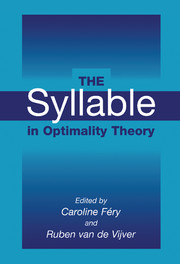Book contents
- Frontmatter
- Contents
- List of Contributors
- Preface
- The Syllable in Optimality Theory
- Part One INTRODUCTION
- Part Two SYLLABLE STRUCTURE AND PROSODIC STRUCTURE
- Part Three NONMORAIC SYLLABLES AND SYLLABLE EDGES
- 6 Syllables and Moras in Arabic
- 7 Semisyllables and Universal Syllabification
- 8 Onsets and Nonmoraic Syllables in German
- 9 Extrasyllabic Consonants and Onset Well-Formedness
- 10 Beyond Codas: Word and Phrase-Final Alignment
- Part Four SEGMENTS AND SYLLABLES
- Part Five HOW CONCRETE IS PHONOTACTICS?
- Author Index
- Languages Index
- Subject Index
8 - Onsets and Nonmoraic Syllables in German
Published online by Cambridge University Press: 03 July 2009
- Frontmatter
- Contents
- List of Contributors
- Preface
- The Syllable in Optimality Theory
- Part One INTRODUCTION
- Part Two SYLLABLE STRUCTURE AND PROSODIC STRUCTURE
- Part Three NONMORAIC SYLLABLES AND SYLLABLE EDGES
- 6 Syllables and Moras in Arabic
- 7 Semisyllables and Universal Syllabification
- 8 Onsets and Nonmoraic Syllables in German
- 9 Extrasyllabic Consonants and Onset Well-Formedness
- 10 Beyond Codas: Word and Phrase-Final Alignment
- Part Four SEGMENTS AND SYLLABLES
- Part Five HOW CONCRETE IS PHONOTACTICS?
- Author Index
- Languages Index
- Subject Index
Summary
This chapter considers the status of nonappendical word-final consonants and proposes an analysis in which they project a nonmoraic semisyllable (see Cho and King, this volume, for a similar proposal for Georgian, Polish, and Bella Coola and Féry, to appear, for French). More specifically, such consonants are onsets of syllables with no nuclei. This analysis improves on alternative proposals on several grounds. First, syllables are maximally bimoraic, which renders the assumption that German has trimoraic syllables unnecessary. German behaves in this respect like most other languages in obeying a bimoraic maximum for syllables. Second, puzzling properties of laryngeals and of [g] after a dorsal nasal are accounted for. In a nutshell, the laryngeals, [h] and [?], as well as [g] after a dorsal nasal are only realized when they are the onsets of higher prosodic constituents, like prosodic word, foot, and moraic syllables, but not as onsets of nonmoraic syllables, like schwa syllables and semisyllables. Finally, that some final consonants contribute weight can be accounted for. The semisyllable they project is the weak member of a final syllabic trochee. This has the advantage of rendering feet consisting of super-heavy syllables superfluous.
In the first section of this chapter, some basic facts about the syllable structure of German are presented. In section 8.2, the role of the prosodic hierarchy in determining the presence of an onset is given an optimality-theoretic analysis. The analysis relies on the assumption that the prosodic constituents form a natural markedness hierarchy.
- Type
- Chapter
- Information
- The Syllable in Optimality Theory , pp. 213 - 237Publisher: Cambridge University PressPrint publication year: 2003
- 4
- Cited by



